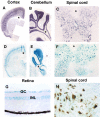Disruption of Nectin-like 1 cell adhesion molecule leads to delayed axonal myelination in the CNS
- PMID: 19036974
- PMCID: PMC2728619
- DOI: 10.1523/JNEUROSCI.2665-08.2008
Disruption of Nectin-like 1 cell adhesion molecule leads to delayed axonal myelination in the CNS
Abstract
Nectin-like 1 (Necl-1) is a neural-specific cell adhesion molecule that is expressed in both the CNS and PNS. Previous in vitro studies suggested that Necl-1 expression is essential for the axon-glial interaction and myelin sheath formation in the PNS. To investigate the in vivo role of Necl-1 in axonal myelination of the developing nervous system, we generated the Necl-1 mutant mice by replacing axons 2-5 with the LacZ reporter gene. Expression studies revealed that Necl-1 is exclusively expressed by neurons in the CNS. Disruption of Necl-1 resulted in developmental delay of axonal myelination in the optic nerve and spinal cord, suggesting that Necl-1 plays an important role in the initial axon-oligodendrocyte recognition and adhesion in CNS myelination.
Figures




References
-
- Biederer T. Bioinformatic characterization of the SynCAM family of immunoglobulin-like domain-containing adhesion molecules. Genomics. 2006;87:139–150. - PubMed
-
- Biederer T, Sara Y, Mozhayeva M, Atasoy D, Liu X, Kavalali ET, Südhof TC. SynCAM, a synaptic adhesion molecule that drives synapse assembly. Science. 2002;297:1525–1531. - PubMed
-
- Colello RJ, Pott U. Signals that initiate myelination in the developing mammalian nervous system. Mol Neurobiol. 1997;15:83–100. - PubMed
-
- Edgar JM, Garbern J. The myelinated axon is dependent on the myelinating cell for support and maintenance: molecules involved. J Neurosci Res. 2004;76:593–598. - PubMed
Publication types
MeSH terms
Substances
Grants and funding
LinkOut - more resources
Full Text Sources
Other Literature Sources
Molecular Biology Databases
